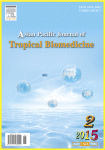 The first author of a review article on extracting pharmacological compounds from marine organisms, published in the Asian Pacific Journal of Tropical Biomedicine, has retracted it due to plagiarism.
The first author of a review article on extracting pharmacological compounds from marine organisms, published in the Asian Pacific Journal of Tropical Biomedicine, has retracted it due to plagiarism.
There were also some authorship issues, according to the retraction notice for the paper, which absolves the last author, based at Pondicherry University in India, from responsibility:
This article has been retracted at the request of the Editor-in-Chief and the First Author. Both the first author and the journal’s editor confirmed that Dr. A Yogamoorthi is not responsible for the plagiarism since his/her name was added without consent.
There is one other author, R. Siva Sankar, also based at Pondicherry. Somewhere along the way, according to the retraction note, the paper scooped up wording from six papers previously published by researchers in Australia. Here’s more from the retraction note for “Antimicrobial secondary metabolites from marine gastropod egg capsules and egg masses”:
The authors have plagiarized parts of various papers that had already appeared as follows:
1 Westley, C.B., McIver, C.M., Abbott, C.A., Le Leu, R.K. and Benkendorff, K.,. Enhanced acute apoptotic response to azoxymethane-induced DNA damage in rodent colonic epithelium by Tyrian purple precursors: A potential colorectal cancer chemopreventative. Cancer Biol Ther 2010; 9(5): 371-379. Doi: http://dx.doi.org/10.4161/cbt.9.5.10887.
-
2 Benkendorff, K., Davis, A.R., Rogers, C.N. and Bremner, J.B. Free fatty acids and sterols in the benthic spawn of aquatic molluscs, and their associated antimicrobial properties. J Exp Mar Biol Ecol 2005; 316:29-44. Doi: http://dx.doi.org/10.1016/j.jembe.2004.10.001.
-
3 Benkendorff, K. 1999. Bioactive Molluscan Resources and Their Conservation: Chemical and Biological Studies on the Egg Masses of Marine Molluscs. PhD THesis, University of Wollongong
-
4 Edwards, V., Benkendorff, K and Young, F. 2012. Marine compounds selectively induce apoptosis in female reproductive cancer cells but not in primary derived female granulosa cells. Mar Drugs 2012; 10: 64-83. doi: http://dx.doi.org/10.3390/md10010064.
-
5 Benkendorff, K., Pillai, R. and Bremner, J.B. 2,4,5-Tribromo-1H-imidazole in the egg masses of three muricid molluscs. Nat Prod Res 2004; 18: 427-431.49. Noble, W.J., Cocks, R.R., Harris J.O. and Benkendorff, K. 2009. Application of anesthetics for sex identification and bioactive compound recovery from wild Dicathais orbita. J Exp Mar Biol Ecol 2009; 380: 53-60. Doi: http://dx.doi.org/10.1016/j.jembe.2009.09.006
-
6 Benkendorff, K., Davis, A.R. and Bremner J.B. Chemical defense in the egg masses of benthic invertebrates: An assessment of antibacterial activity in 39 molluscs and 4 polychaetes. J Invertebr Pathol 2001; 78: 109-118. Doi: http://dx.doi.org/10.1006/jipa.2001.5047.
Kirsten Benkendorff, a marine ecologist now based at Southern Cross University and an author on all six papers, told us that she was first alerted to the plagiarism by a US colleague in 2012, shortly after the review’s publication. She ran the text through the plagiarism detection program Turnitin:
This revealed a 62% match in the text to 38 sources including at least 16 published papers with full reference details, as well as my PhD thesis and other papers cross referenced to databases or conferences. Of particular concern, the majority of the paragraphs of text in the main body were basically copied word for word from a single source, whereas a few additional paragraphs were compiled from sentences cut and pasted from different sources. I suspect that most of the unmatched text was also copied from sources that are not available electronically because it included statements such as “This thesis focuses on the archaeological….” whist clearly not referring to the authors own work.
Benkendorff immediately contacted the authors and the journal, but the article wasn’t retracted until the February 2015 issue. We contacted the first and second authors as well as the President Executive Editor in Chief of the journal for comment and will update this post if they reply.
The experience gave Benkendorff some food for thought:
Ultimately I found it astounding that it took ~2yrs to retract a paper that was so obviously plagiarised and to such a large extent. I hope I never see anything like this pass the peer-review system again!
The review has been cited once, according to Thomson Scientific’s Web of Knowledge.
Hat tip: Rolf Degen
Like Retraction Watch? Consider supporting our growth. You can also follow us on Twitter, like us on Facebook, add us to your RSS reader, and sign up on our homepage for an email every time there’s a new post.
As soon as it became clear that the journal was dragging its feet over the retraction, Benkendorff should have published the evidence of plagiarism on PubPeer or in a blog post.
his/her name was added without consent
Ah, passive voice! Is there nothing that can’t be accomplished by it?
Why was plagiarism not detected prior to or during peer review? How much text exactly was derived from these 6 sources? Why has a textual side-by-side comparison not been provided by Elsevier?